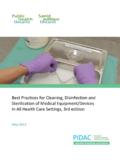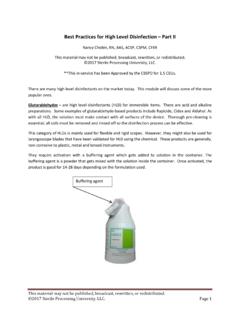Transcription of Sterilization and Disinfection - microrao.com
1 Sridhar Rao ( ) Sterilization and Disinfection Sterilization is defined as the process where all the living microorganisms, including bacterial spores are killed. Sterilization can be achieved by physical, chemical and physiochemical means. Chemicals used as sterilizing agents are called chemisterilants. Disinfection is the process of elimination of most pathogenic microorganisms (excluding bacterial spores) on inanimate objects. Disinfection can be achieved by physical or chemical methods.
2 Chemicals used in Disinfection are called disinfectants. Different disinfectants have different target ranges, not all disinfectants can kill all microorganisms. Some methods of Disinfection such as filtration do not kill bacteria, they separate them out. Sterilization is an absolute condition while Disinfection is not. The two are not synonymous. Decontamination is the process of removal of contaminating pathogenic microorganisms from the articles by a process of Sterilization or Disinfection .
3 It is the use of physical or chemical means to remove, inactivate, or destroy living organisms on a surface so that the organisms are no longer infectious. Sanitization is the process of chemical or mechanical cleansing, applicable in public health systems. Usually used by the food industry. It reduces microbes on eating utensils to safe, acceptable levels for public health. Asepsis is the employment of techniques (such as usage of gloves, air filters, uv rays etc) to achieve microbe-free environment. Antisepsis is the use of chemicals (antiseptics) to make skin or mucus membranes devoid of pathogenic microorganisms.
4 Bacteriostasis is a condition where the multiplication of the bacteria is inhibited without killing them. Bactericidal is that chemical that can kill or inactivate bacteria. Such chemicals may be called variously depending on the spectrum of activity, such as bactericidal, virucidal, fungicidal, microbicidal, sporicidal, tuberculocidal or germicidal. Antibiotics are substances produced by one microbe that inhibits or kills another microbe. Often the term is used more generally to include synthetic and semi-synthetic antimicrobial agents.
5 PHYSICAL METHODS OF Sterilization : Sunlight: The microbicidal activity of sunlight is mainly due to the presence of ultra violet rays in it. It is responsible for spontaneous Sterilization in natural conditions. In tropical countries, the sunlight is more effective in killing germs Sridhar Rao ( ) due to combination of ultraviolet rays and heat. By killing bacteria suspended in water, sunlight provides natural method of Disinfection of water bodies such as tanks and lakes. Sunlight is not sporicidal, hence it does not sterilize.
6 Heat: Heat is considered to be most reliable method of Sterilization of articles that can withstand heat. Heat acts by oxidative effects as well as denaturation and coagulation of proteins. Those articles that cannot withstand high temperatures can still be sterilized at lower temperature by prolonging the duration of exposure. Factors affecting Sterilization by heat are: o Nature of heat: Moist heat is more effective than dry heat o Temperature and time: temperature and time are inversely proportional.
7 As temperature increases the time taken decreases. o Number of microorganisms: More the number of microorganisms, higher the temperature or longer the duration required. o Nature of microorganism: Depends on species and strain of microorganism, sensitivity to heat may vary. Spores are highly resistant to heat. o Type of material: Articles that are heavily contaminated require higher temperature or prolonged exposure. Certain heat sensitive articles must be sterilized at lower temperature.
8 O Presence of organic material: Organic materials such as protein, sugars, oils and fats increase the time required. Action of heat: Dry heat acts by protein denaturation, oxidative damage and toxic effects of elevated levels of electrolytes. The moist heat acts by coagulation and denaturation of proteins. Moist heat is superior to dry heat in action. Temperature required to kill microbe by dry heat is more than the moist heat. Thermal death time is the minimum time required to kill a suspension of organisms at a predetermined temperature in a specified environment.
9 DRY HEAT: Red heat: Articles such as bacteriological loops, straight wires, tips of forceps and searing spatulas are sterilized by holding them in Bunsen flame till they become red hot. This is a simple method for effective Sterilization of such articles, but is limited to those articles that can be heated to redness in flame. Flaming: This is a method of passing the article over a Bunsen flame, but not heating it to redness. Articles such as scalpels, mouth of test tubes, flasks, glass slides and cover slips are passed through the flame a few times.
10 Even though most vegetative cells are killed, there is no guarantee that spores too would die on such short exposure. This method too is limited to those articles that can be exposed to flame. Cracking of the glassware may occur. Incineration: This is a method of destroying contaminated material by burning them in incinerator. Articles such as soiled dressings; animal carcasses, pathological material and bedding etc should be subjected to incineration. This technique results in the loss of the article, hence is suitable only for those articles that have to be disposed.











